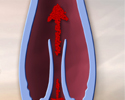Venous ulcers - self-care
Venous leg ulcers - self-care; Venous insufficiency ulcers - self-care; Stasis leg ulcers - self-care; Varicose veins - venous ulcers - self-care; Stasis dermatitis - venous ulcer
Venous ulcers (open sores) can occur when the veins in your legs do not push blood back up to your heart as well as they should. Blood backs up in the veins, building up pressure. If not treated, increased pressure and excess fluid in the affected area can cause an open sore to form.
Most venous ulcers occur on the leg, above the ankle. This type of wound can be slow to heal.
Causes
The cause of venous ulcers is high pressure in the veins of the lower leg. The veins have one-way valves that keep blood flowing up toward your heart. When these valves become weak or the veins become scarred and blocked, blood can flow backward and pool in your legs. This is called venous insufficiency. This leads to high pressure in the lower leg veins. The increase in pressure and buildup of fluid prevents nutrients and oxygen from getting to tissues. The lack of nutrients causes cells to die, damaging the tissue, and a wound can form.
Signs and Symptoms
When blood pools in the veins of the lower leg, fluid and blood cells leak out into the skin and other tissues. This can cause itchy, thin skin and lead to skin changes (for example faint, light red discoloration) called stasis dermatitis. This is an early sign of venous insufficiency.
Other early signs include:
- Leg swelling, heaviness, and cramping
- Dark red, purple, brown, hardened skin (this is a sign that blood is pooling)
- Itching and tingling
Signs and symptoms of venous ulcers include:
- Shallow sore with a red base, sometimes covered by yellow tissue
- Unevenly shaped borders
- Surrounding skin may be shiny, tight, warm or hot, and discolored
- Leg pain
- If the sore becomes infected, it may have a bad odor and pus may drain from the wound
Who is At Risk?
Risk factors for venous ulcers include:
- Varicose veins
- History of blood clots in the legs (deep vein thrombosis)
- Blockage of the lymph vessels, which causes fluid to build up in the legs
- Older age, being female, or being tall
- Family history of venous insufficiency
- Obesity
- Pregnancy
- Smoking
- Sitting or standing for a long periods of time (usually for work)
- Fracture of a long bone in the leg or other serious injuries, such as burns, muscle damage, or a large surgery
Wound Care
Your health care provider will show you how to care for your wound. The basic instructions are:
- Always keep the wound clean and bandaged to prevent infection.
- Your provider will tell you how often you need to change the dressing.
- Keep the dressing and the skin around it dry. Try not to get healthy tissue around the wound too wet. This can soften the healthy tissue, causing the wound to get bigger.
- Before applying a dressing, cleanse the wound thoroughly according to your provider's instructions.
- Protect the skin around the wound by keeping it clean and moisturized.
- You will wear a compression stocking or bandages over the dressing. Your provider will show you how to apply the bandages.
To help treat a venous ulcer, the high pressure in the leg veins needs to be relieved.
- Wear compression stockings or bandages every day as instructed. They help prevent blood from pooling, reduce swelling, help with healing, and reduce pain.
- Put your feet above your heart as often as possible. For example, you can lie down with your feet propped up on pillows.
- Take a walk or exercise every day. Being active helps improve blood flow.
- Take medicines as directed to help with healing.
If ulcers do not heal well, your provider may recommend certain procedures or surgery to improve blood flow through your veins.
Prevention
If you are at risk for venous ulcers, take the steps listed above under Wound Care. Also, check your feet and legs every day: the tops and bottoms, ankles, and heels. Look for cracks and changes in skin color.
Lifestyle changes can help prevent venous ulcers. The following measures may help improve blood flow and aid healing.
- Keep the skin of your lower legs well moisturized.
- Quit smoking. Smoking is bad for your blood vessels.
- If you have diabetes, keep your blood sugar level under control. This will help you heal faster.
- Exercise as much as you can. Staying active helps with blood flow.
- Eat healthy foods and get plenty of sleep at night.
- Lose weight if you are overweight.
- Manage your blood pressure and cholesterol levels.
When to Call the Doctor
Contact your provider if there are any signs of infection, such as:
- Redness, increased warmth, or swelling around the wound
- More drainage than before or drainage that is yellowish or cloudy
- Bleeding
- Odor
- Fever or chills
- Increased pain
References
Andrews KL, Derby KM, Jacobson TM, Sievers BA, Kiemele LJ. Prevention and management of chronic wounds. In: Cifu DX, ed. Braddom's Physical Medicine and Rehabilitation. 6th ed. Philadelphia, PA: Elsevier; 2021:chap 24.
Bolognia JL, Schaffer JV, Cerroni L. Ulcers. In: Bolognia JL, Schaffer JV, Cerroni L, eds. Dermatology. 5th ed. Philadelphia, PA: Elsevier; 2025:chap 105.
Boukovalas S, Aliano KA, Phillips LG, Norbury WB. Wound healing. In: Townsend CM Jr, Beauchamp RD, Evers BM, Mattox KL, eds. Sabiston Textbook of Surgery. 21st ed. St Louis, MO: Elsevier; 2022:chap 6.
Review Date: 6/11/2024
Reviewed By: Deepak Sudheendra, MD, MHCI, RPVI, FSIR, CEO & Medical Director, 360 Vascular Institute, with an expertise in Vascular Interventional Radiology & Surgical Critical Care, Columbus, OH. Review provided by VeriMed Healthcare Network. Also reviewed by David C. Dugdale, MD, Medical Director, Brenda Conaway, Editorial Director, and the A.D.A.M. Editorial team.


